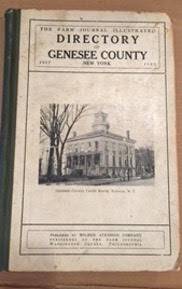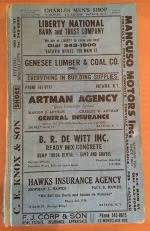
I was given some old books to look through for a possible article. I chose The First Directory of the Village of Batavia 1877-78 and a phone directory from 1950-51. You get a peek into what life might have been like during those eras.
The early directory gives a little history of the village of 6,000. The Court House on Main and Ellicott was built in 1842 with a jail. The county clerk and surrogate's offices were in the front of Main Street.
The small book explained the New York State Institution for the Blind. It also named the churches in the village: St. James Episcopal Church, The First Presbyterian Society of Batavia, the Baptist Society, St. Joseph's Roman Catholic Church, and the Methodist Church.
There were three newspapers: The Progressive Batavian, Republican Advocate, and Spirit of the Times.
There were six schools, three public and three private.
The largest manufacturer was Wiard Plow. The Batavia Portable Steam Engine Company was another notable enterprise. Genesee Agricultural Works on Ellicott Street sold every possible farm implement used in farming, and all were operated by horse or steam power. Two hose companies took care of the village that was lighted by gas. A dollar store sold glassware, crockery, china lamps, and chandeliers. All goods were warrantied and sold for 99 cents and were cheerfully shown.
The streets listed in the directory mainly were Main Street, Ellicott Street, River, Lyons, Evans, Oak, Walnut, Ross, Cherry, Bank, and Union Street. The book contains 46 pages; of the 46 pages, 14 include the names and streets of the villagers.

The 1950 phone directory had a hole at the corner of the book for you to hang near your stationary phone. Also interesting were the phone numbers. There were phone numbers with 2, 3, and 4 digit numbers, and a letter followed some phone numbers. A phone call outside Batavia but within the county costs 10 and 15 cents. Buffalo was 35 cents, and Seattle, Washington, $2.45.
The job of the operator was vital. All calls out of the area required an operator.
According to the Yellow Pages, you could buy a car from 28 places. Some names you don't hear today were DeSoto, Nash, and Studebaker.
Adding machines were also a very popular item to buy from many area stores, along with an address machine. There were seven department stores, 28 fruit and vegetable growers, 60 restaurants, 13 hotels, and 10 furniture stores. One ad I found interesting and a little upsetting was: "Dead Animal Removal, we buy grease, fat, bones, hides and skins. The highest price paid for horses, cows, sheep, and hogs."
There were so many auto repair places that they took up an entire page.
Before Dunkin Donuts, there were Freddie's and Jackie's Doughnuts. Many homes sold eggs because they had chickens in their back yards. You could buy baby chicks by calling the phone number 2150, which is listed in the advertisements.
Most homes were heated with coal. Colantonio Coal Co., Holland Furnaces, and Thomas Wood and Coal were the most popular places to buy coal. There were also 40 gas stations and 40 small grocery stores, most likely on every corner. The book was 180 pages long, and 81 pages contained the residents' names, addresses, and phone numbers.
Today, we have Dollar Stores, which are considered department stores. You can also rent furniture and appliances and lease a car.
Some things do stay the same. Looking through the 1950 city directory, I recognized some existing establishments. In no particular order they are: Max Pies, Arctic Refrigeration, Sallome Heating, Bohm Mortuary, Falcone Electric/Green Mountain Electric Supply, Genesee Lumber, Dougherty Heating, Batavia Downs, Batavia Players, McAndrew Funeral Home, Chapin Manufacturing, Adam Miller, Oliver's, Northside Grocery, Pero's Plumbing, Polish Falcons, H.E. Turner Mortuary, WBTA, YMCA, YWCA, Charles Men's Shop, American Legion, Miss Batavia Diner, The Kelly's Holland Inn, Mancuso Bowling Lanes, Wortzman Furniture, Max Pies Furniture, Upson and Maybeck, Knights of Columbus, Batavia Marine Sporting Goods, R.A. Haitz, and Wills Wallpaper and Paint.
Please share the names of any other businesses from 75 years ago that are still here today.
Back in the day, your phone book and directories were "smart device" connections to the world around you. Today, you can find everything you need on your iPhone.
